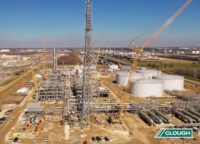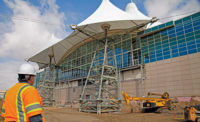Ask Anthony Bond, the fifth-generation family leader of BOND Civil & Utility Construction, about his firm’s success, significant growth and increased revenue, and he’ll talk about new ideas, innovations and the firm’s corps of employees.
“One reason we’ve been able to make it to five generations is that we are always looking to invest in the right people and do the right thing—and what we can do to make it a lasting success,” he says, calling employees the firm’s “best assets.”
Bond was appointed president on Jan. 1, 2019, with the firm—owned by Massachusetts-based BOND Brothers Inc.—hiring 24 new staff members for the New York and New Jersey region and 152 companywide. In its latest fiscal year that ended in October 2019, BOND Civil & Utility reported regional revenue of $70 million, up 87% compared to the same period in 2018.
That boost in revenue and staff, along with technological innovations, has propelled BOND Civil & Utility to earn ENR New York’s Specialty Contractor of the Year designation.
Being at the helm of the firm came naturally to Bond, known as Tony. He recalls visiting the BOND Brothers office as a child with his father, Ed Bond, who knew everyone there. At home, the elder Bond talked less about project challenges and more about the company’s employees.
“My father always said to hire people smarter than you,” says Bond, adding that it’s important to care about their well-being. “If there’s anything we know growing up in a family company, it’s to make sure everyone goes home safely. Don’t sacrifice safety. Instead, create lasting success.”
Still, projects are what make the company stand out. A $20-million upgrade for an existing metering and regulation gas transmission facility, located in Ramapo, N.Y., was the firm’s largest regional project completed in 2019. In Carlstadt, N.J., a $28.5-million liquefied natural gas facility modernization project was its largest to break ground last year. The firm declines to disclose owners’ identities.
“Many of our projects are confidential as they involve critical gas and electric utility infrastructure, and they all come with their own set of challenges,” Bond explains.
“The major theme across all our projects is the complexity to the site logistics. Whether it is installing 36-inch transmission pipe through the congested streets in the Bronx or delivering complex mechanical and electrical packages on existing sites in Brooklyn, we pride ourselves on having the teams and the history of delivering on these project types and anticipating the challenges that may come about.”
The executive adds that “our job is to work with our clients, identify what those potential issues may be and develop the appropriate risk mitigation plans to ensure that the project can still be delivered as timely and cost effectively as possible.”
The firm cites several innovations with software in the past year that has aided project delivery. In 2019 it provided feedback to construction software firm HCSS on development of its HCSS Aerial product to assist, via a testing program, in getting it market-ready. HCSS Aerial builds 3D point clouds from drone photogrammetry that allows teams to acquire models with a 1-in. accuracy.
Bond says his company develops tech because “the construction industry has been slow to adopt technology over the years, and we like to push ourselves on the technology front.”
He adds: “I think we were one of the first companies to push iPhones and iPads to our management teams as well as to crews and have them become standard issue items for all existing and new employees.”
Bond says the contractor has “been one of the earliest adopters of the HCSS suite of products, including HeavyBid and HeavyJob,” and that his company continues to work with the vendor “to refine our processes and determine new ways to bring value to our clients and project teams.”
Bond also talks about the firm maintaining its 100-year-old culture and standards while expanding into different markets and regions, emphasizing its need to be “effectively engaged with our employees, no matter where they are working.”
Kane Cuddy, firm chief operating officer, credits Bond’s instincts in growing the business, introducing cutting-edge technology and providing an environment where employees can enjoy long-term careers.
“He knows how we all operate,” says Cuddy, a 17-year employee who “started as an intern” when the firm was “a much smaller company.” He adds that “even though we’ve grown in Connecticut, Rhode Island and New York and we’re expanding to New Jersey, it doesn’t feel any different than when we started.”
Cuddy admits that COVID-19 hit the firm’s construction sites hard, but says staff “did an excellent job of digging in. We created committees and teams, and were communicating with clients about what the next actions were. We knew that in a time of panic, communication was key.”
Dan Foppiano, a vice president based in New York City, says getting the right team in place was key to finishing jobs on time. Employees who stay with the company because of its focus on safety and its family-first culture, he says, adding, “At the end of the day on the construction site, the most important thing is that everyone goes home safely.”
Foppiano began working at BOND Civil & Utility about five years ago. “Working for BOND is like a breath of fresh air,” says Foppiano, adding that employees and company leaders all share “in core values and culture, which is something we’re pretty proud of. To me that’s important. We want to recruit the right people who share in our work ethic.”
The company’s president, in turn, credits Foppiano with putting together a successful team in New York City. When the firm hired him, “the thing that stood out was that Dan really exemplified the culture and values we uphold,” Bond says.
And that’s what helped the company increase its business in New York and New Jersey, he contends.
“Without a doubt, it was relationships with clients that led to these projects and growth,” Bond adds. “This is a team that can step up to the challenges of an ever-changing mix of projects with the toughest environments.”
He cites “repeat clients and repeat individuals with which we’ve built up long-lasting relationships. Dan and a lot of the team he’s built, these are people who know who to call.”
Bond explains the firm’s regional growth trajectory. “We started in the area of doing smaller mains and services work,” which led to clients tapping the firm to perform “more complex work, including transmission mains and, currently, a focused program of LNG work at existing facilities,” Bond says. “Our clients also have trusted us with more complicated delivery structures … which has further helped establish our footprint in this market.”
Anthony Badalamenti, vice president of operations for Long Island-based E-J Electric Installation Co., worked with BOND Civil & Utility on a gas plant upgrade at the Starrett City residential complex in Brooklyn, in which the team added two reciprocating generators. Badalamenti says he was impressed by safety plans that the contractor put in place.
“Overall, I think they run a very strong safety program,” he says. “They have a good core foundation in their safety program and it makes them very easy to work with. We hold our safety program in similar regard.”
Badalamenti, a veteran of 27 years in plant and industrial construction work, adds that BOND Civil & Utility is “a very good company and I enjoy their projects,” adding that the firm’s ”values are just like our values.”
When The Brooksville Co. needed work on a power plant at Spring Creek Towers in Brooklyn that Bill Foley, senior director of facilities operations, says “was in a residential community dependent on power from that source,” it turned to BOND Civil & Utility.
“There were 46 buildings in Brooklyn with no connection to the grid,” Foley recalls, saying the job needed to be done quickly without disturbing the neighborhood. Amid the COVID-19 pandemic, social distancing and construction site health and safety guidelines made the task more daunting.
“What BOND handled really well was the understanding that it was an occupied residence,” Foley says, and it made sure residents “would be impacted as minimally as possible. BOND did a terrific job.”










Post a comment to this article
Report Abusive Comment